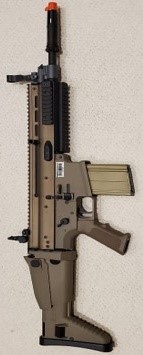Weapons, Firearms Management
SageData is based in Ottawa, Ontario, Canada
Management Of Guns, Carbines, Rifles Can Be Challenging
A common request is for a system to manage dangerous items, which includes firearms - pistols, carbines, rifles, but can sometimes include other weapons. Over the years we have installed many systems for managing weapons safely, and they generally fall into two categories based on the activity level.
Forensic Crime Lab, Training Establishments Case
In the more viscous
systems, there is less movement.
Weapons are tracked into a secure vault, and remain there for long periods of time. This can
apply
to
training establishments, laboratory environments, and forensic crime labs. In this case, the
main
objective is to provide rapid confirmation of inventory. A single missing firearm is a cause for
alarm.
Police, Military Forces Case
The other category is for active duty situations, typical of police forces, or some military training operations. In this case weapons are regularly issued, often for a short period, perhaps a working shift or a training session. The weapons are returned at the end of the shift or the end of the training session. There are many weapons issued in a short period of time, but there is the requirement to know which weapon was issued to which individual, and to ensure that all weapons are returned at the appointed time.
How To Identify Weapons?

There are four ways to identify weapons to help manage these issues and returns:
- Serial number
- Barcodes
- Passive RFID
- Active RFID
Serial Number
Serial number can be appropriate for a low level of long term issues, for weapons to be returned when the individual moves on to a new job. The disadvantages include difficulty in accurately reading and entering the correct serial number.
Barcodes
Barcodes are effective. There is some overhead in the initial application, and there may be issues when a barcode is removed during service of the weapon. But generally they make the tracking of issues and returns easy, fast and accurate. Disadvantages include damage to the barcoded asset tag, and difficulty in completing inventory counts when there are a large number of weapons.
Passive RFID UHF
This permits ID tags to be applied in an inconspicuous location, such as within the stock of a carbine, or in the handle of a pistol, next to the magazine. It has the advantage when performing an inventory that a large number of weapons can be verified very quickly. An inventory of a thousand weapons can be verified in less than ten minutes, with each weapon individually identified. The only limitation is the read range, which, in real life situations, is typically a metre or so when tags are read with a handheld RFID reader.
Active RFID
This technology expands the range at which a tag can be read (and thus the range at which a weapon can be identified). It also enables continuous monitoring, so that the removal of an individual weapon can be instantly detected and reported (unless, of course, the removal is authorized). This technology is good for inventory purposes, and the inventory can be set up to operate full time, with no human intervention. But it also means that the checkout functions cannot usually rely on the active tags for ID, as there will generally be many tags in range. Other issues include increased cost, and the finite lifetime of the tag - though at five years, this may not be an issue in many applications.

In Summary
These identification technologies, when coupled with appropriate software (such as SageData BassetPro), can provide accurate control over weapons, help meet mandated requirements for reporting, dramatically reduce the time to perform inventory confirmations, and improve the integrity of the data shown in the required reports.
These systems are used by regular Police Forces, by Tactical Teams, and by DND for routine patrol and training exercises. But they can also be used at events such as the G7, where they can track not only weapons, but also vehicles, first aid kits, radios, pepper spray, gas masks and much more. Each case is different.
A standard software package requires you to change your processes to match the software. Our systems are designed so that they can be configured to match your requirements. That reduces training needs, makes them easy to use, and ensures that you not only manage weapons safely, but also have the ability to readily produce proof of compliance.
Some humor as a conclusion
One of our clients related the following. They sent a weapon to the armourer
for
routine inspection and maintenance. The armourer found that the barrel was obstructed by a
strange
grey
substance. On analysis that turned out to be - used chewing gum. Clearly the consequence of a
long,
boring, stint as guard detail. The BassetPro System made it quick and easy to identify the
chewer
.
Inspection of other weapons issued to that individual showed similar obstructions. After a short
(but
loud) conversation with a superior officer, for a little re-training
, the individual was
encouraged to
find an alternative depository for used gum.
If you found this useful, you might also want to review:
- firearms inventory management - a brief
video
- an introduction to asset
management
- an introduction to WMS -
warehouse management systems
- an
introduction to barcode technologies
QAOK5355
